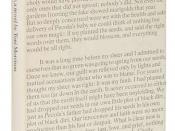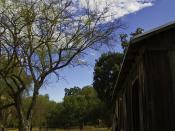RACIAL SELF LOATHING IN THE BLUEST EYE
In "The Bluest Eye", author Toni Morrison builds a story around the concept of racial self-hatred and how it comes to exist in the mind of a young child. "The Bluest Eye" deals directly with the individual psychology of the main character, Pecola Breedlove. So intense are Pecola's feelings of self-loathing and inferiority that she would do anything to soothe them. In her young mind, she needs a miracle; she needs the bluest eyes. All of the tragedies in this novel can be directed back to one main issue, whiteness as a standard of beauty. This belief that white sets the standards for beauty is a major factor to the racial self-loathing, which occurred in America in the past as well as today. The show of racism through white beauty, and the desires of the black society to acquire this beauty, led to the destruction of many characters in this book.
'The Bluest Eye" provides a description of the ways in which internalized white beauty standards disfigure the lives of black girls and women. Obvious messages that whiteness is superior are everywhere, for example the white baby doll given to Claudia, the praising of Shirley Temple, the fact that the light-skinned Maureen is cuter than the other black girls, the idealization of white beauty in the movies, and Pauline Breedlove's preference for the little white girl she works for over her daughter. Adult women, having learned to hate the blackness of their own bodies, take this hatred out on their children Mrs. Breedlove shares the conviction that Pecola is ugly. The lighter-skinned Geraldine also curses Pecola's blackness. Claudia remains free from this worship of whiteness, but she does realize that society does, imagining Pecola's unborn baby as beautiful in its...



Bluest Eye
This is a great essay! It was clear, concise and well thought out. Having already read the book I found this essay to be accurate in its representation of the novel. Great job!
1 out of 1 people found this comment useful.